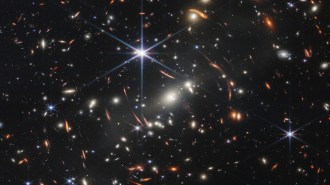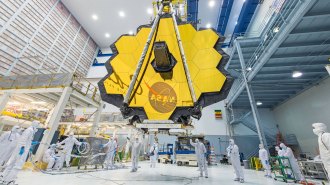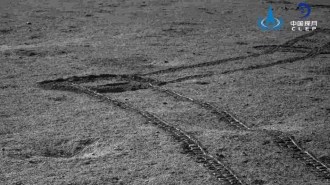Search Results
Defining and defying Roche limits
Students will review force diagrams and gravitational force and discuss planetary ring and moon formation using the concept of the Roche limit.
Learning Outcomes: Applying gravitational forces and interactions in space to understand ring and moon formation.

Postcards From a New Space Telescope
Have you heard about the James Webb Space Telescope’s stunning first images of deep space? Use this guide to help students explore the science behind pictures of exploding stars, dancing galaxies, cosmic cliffs and more, and discuss how images can be thought of as data.
Pushing the boundaries of outer space
Students will answer questions about the Science News article “Here are the James Webb Space Telescope’s stunning first pictures,” which highlights dazzling cosmic wonders seen in farthest and clearest views yet of deep space. A version of the article, “Postcards from a new space telescope,” appears in the August 13, 2022 issue of Science News.
New space images dazzle with data
Share a universal celebration in science with images of deep space from the James Webb Space Telescope. Have students collaborate to think about the science shown in the images and the implications of images as data.
Learning Outcomes: Observe, interpret and compare data in images; explore universal questions about science.

The Origami Satellite
In this guide, students will learn about NASA’s James Webb Space Telescope and discuss how scientific advances have shaped the telescope’s mission.
Unlocking universal questions
Students will discuss the mission of the James Webb Space Telescope and explore how scientific discoveries over the last few decades have shaped the telescope’s to-do list.
Getting ready for lift-off
Students will answer questions about the online Science News article “When James Webb launches, it will have a bigger to-do list than 1980s researchers suspected,” which details the long journey of NASA’s James Webb Space Telescope to make it into space to explore other galaxies. A version of the story, “The origami satellite,” appears in the October 9, 2021 & October 23, 2021 issue of Science News.
The hunt for other worlds
Students will research exoplanets and their properties and detection methods. Then students will use fictitious data to create a light curve of a transiting exoplanet and to calculate the exoplanet’s motion through its solar system.

A Weird Solar System Cousin Makes Its Photographic Debut
In this guide, students will examine a photograph of a distant solar system, learn how astronomers captured the image and learn about the system’s inhabitants. Students will then discuss units of measure and create a scaled drawing of the distant solar system.
Capturing an exoplanet family portrait
Students will answer questions about the online Science News article “This is the first picture of a sunlike star with multiple exoplanets,” which describes a young solar system 300 light-years from our own. A version of the story, “A weird solar system cousin makes its photographic debut,” can be found in the August 29, 2020 issue of Science News.
Why use units
To determine the purpose of units in science, students will identify and compare the units used for common outer space measurements with units typically used for Earth measurements. Then, students will think about the importance of using standard units versus relative values when describing data before creating a scaled drawing of exoplanet distances.

Rover Peers Beneath Moon’s Farside
In this guide, students will explore the moon’s geology and learn how to display and interpret data through diagrams. In an activity, students will use their knowledge of Earth’s rock cycle to analyze data on rock samples.